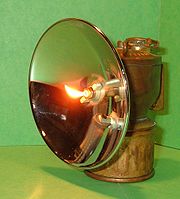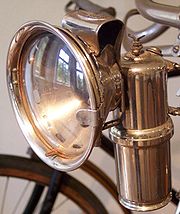
Carbide lamp
Encyclopedia


Acetylene
Acetylene is the chemical compound with the formula C2H2. It is a hydrocarbon and the simplest alkyne. This colorless gas is widely used as a fuel and a chemical building block. It is unstable in pure form and thus is usually handled as a solution.As an alkyne, acetylene is unsaturated because...
(C2H2) which is created by the reaction of calcium carbide
Calcium carbide
thumb|right|Calcium carbide.Calcium carbide is a chemical compound with the chemical formula of CaC2. The pure material is colorless, however pieces of technical grade calcium carbide are grey or brown and consist of only 80-85% of CaC2 . Because of presence of PH3, NH3, and H2S it has a...
(CaC2) with water.
Acetylene gas lamps were used to illuminate buildings, as lighthouse
Lighthouse
A lighthouse is a tower, building, or other type of structure designed to emit light from a system of lamps and lenses or, in older times, from a fire, and used as an aid to navigation for maritime pilots at sea or on inland waterways....
beacons, and as headlights on motor-cars and bicycles. Portable carbide lamps, worn on the hat or carried by hand, were widely used in mining in the early twentieth century. They are still employed by cavers, hunters, and cataphile
Cataphile
Cataphiles are urban explorers who illegally tour the Paris "catacombs", the term popularly used to describe a series of underground tunnels that were formerly a network of stone mines.-Unauthorized visits:Entrance to the catacombs is restricted...
s.
Mechanism
The conventional process of producing acetylene in a lamp involves putting the calcium carbide in the lower chamber (the generator). The upper reservoir is then filled with water. A threaded valve or other mechanism is used to control the rate at which the water is allowed to drip onto the chamber containing the calcium carbide. By controlling the rate of water flow, the production of acetylene gas is controlled. This, in turn, controls the flow rate of the gas and the size of the flame at the burner, (and thus the amount of light it produces).This type of lamp generally has a reflector behind the flame to help project the light forward. An acetylene gas powered lamp produces a surprisingly bright, broad light. Many cavers prefer this type of unfocused light as it improves peripheral vision in the complete dark. The reaction of carbide with water produces a fair amount of heat independent of the flame. In cold caves, carbide lamp users can use this heat to help stave off hypothermia.
When all of the carbide in a lamp has been reacted, the carbide chamber contains a wet paste of slaked lime (calcium hydroxide
Calcium hydroxide
Calcium hydroxide, traditionally called slaked lime, is an inorganic compound with the chemical formula Ca2. It is a colourless crystal or white powder and is obtained when calcium oxide is mixed, or "slaked" with water. It has many names including hydrated lime, builders lime, slack lime, cal, or...
). This is emptied into a waste bag and the chamber can be refilled.
Small carbide lamps called "carbide candles" are used for blackening rifle sights to reduce glare. These "candles" are used due to the sooty flame produced by acetylene.
Use in caving
Early cavingCaving
Caving—also occasionally known as spelunking in the United States and potholing in the United Kingdom—is the recreational pastime of exploring wild cave systems...
enthusiasts, not yet having the advantage of light-weight electrical illumination, introduced the carbide lamp to their hobby. While increasingly replaced by more modern choices, a substantial percentage of cavers still use this method.
In cave surveys, carbide lamps are favored for the lead or "point" surveyor, who must identify suitable points in the cave to designate as survey stations. The sooty carbide flame may be used to harmlessly mark cave walls with a nontoxic and removable station label. Especially favored for this purpose are all-brass lamps or lamps made with no ferromagnetic metals, as these lamps do not deflect the needles of a magnetic compass, which is typically read while brightly illuminated from above using the caver's lamp.
Apart from their use as cave surveying tools, many cavers favor carbide lamps for their durability and quality of illumination. They were once favored for their relative illumination per mass of fuel compared to battery powered devices, but this advantage was largely negated with the advent of high-intensity LED
LEd
LEd is a TeX/LaTeX editing software working under Microsoft Windows. It is a freeware product....
illumination.
The acetylene producing reaction is exothermic
Exothermic
In thermodynamics, the term exothermic describes a process or reaction that releases energy from the system, usually in the form of heat, but also in the form of light , electricity , or sound...
, which means that the lamp's reactor vessel will become quite warm to the touch; this can be used to warm the hands. The heat from the flame can also be used to warm the body by allowing the exhaust gases to flow under a shirt pulled out from the body: such a configuration is referred to as a "Palmer furnace", after geologist Arthur Palmer.
Other uses
Acetylene lamps were also used on riverboats for night navigation. The National Museum of AustraliaNational Museum of Australia
The National Museum of Australia was formally established by the National Museum of Australia Act 1980. The National Museum preserves and interprets Australia's social history, exploring the key issues, people and events that have shaped the nation....
has a lamp made in about 1910 that was used on board PS Enterprise, a paddle steamer
Paddle steamer
A paddle steamer is a steamship or riverboat, powered by a steam engine, using paddle wheels to propel it through the water. In antiquity, Paddle wheelers followed the development of poles, oars and sails, where the first uses were wheelers driven by animals or humans...
which has been restored to working order, and is also in its collection.
History
In 1892, Thomas WillsonThomas Willson
Thomas Leopold "Carbide" Willson was a Canadian inventor.He was born on a farm near Princeton, Ontario in 1860 and went to school in Hamilton, Ontario. By the age of 21, he had designed and patented the first electric arc lamps used in Hamilton...
discovered an economically efficient process for creating calcium carbide, which is used in the production of acetylene gas. In 1895, he sold his patent to Union Carbide. Domestic lighting with acetylene gas was introduced circa 1894 and bicycle lamps from 1896.
The first carbide mining lamp developed in the United States was patent
Patent
A patent is a form of intellectual property. It consists of a set of exclusive rights granted by a sovereign state to an inventor or their assignee for a limited period of time in exchange for the public disclosure of an invention....
ed in New York
New York
New York is a state in the Northeastern region of the United States. It is the nation's third most populous state. New York is bordered by New Jersey and Pennsylvania to the south, and by Connecticut, Massachusetts and Vermont to the east...
on August 28, 1900 by Frederick Baldwin. Another early lamp design is shown in a patent
Patent
A patent is a form of intellectual property. It consists of a set of exclusive rights granted by a sovereign state to an inventor or their assignee for a limited period of time in exchange for the public disclosure of an invention....
from Duluth, Minnesota
Duluth, Minnesota
Duluth is a port city in the U.S. state of Minnesota and is the county seat of Saint Louis County. The fourth largest city in Minnesota, Duluth had a total population of 86,265 in the 2010 census. Duluth is also the second largest city that is located on Lake Superior after Thunder Bay, Ontario,...
on October 21, 1902. In the late 1900s, Gustaf Dalén
Gustaf Dalén
Nils Gustaf Dalén was a Swedish Nobel Laureate and industrialist, the founder of the AGA company and inventor of the AGA cooker and the Dalén light...
invented the Dalén light
Dalén light
The Dalén light was the predominant form of light source in lighthouses from the 1900s through the 1960s, when electric lighting had become dominant. The system was invented by Gustaf Dalén and marketed by his company AGA. Dalén later invented the AGA cooker in 1922. The Dalén light is notable...
. This combined two of Dalén's previous inventions: the substrate Agamassan
Agamassan
Agamassan is a porous substrate used to safely absorb acetylene and thus allow the transport, storage and commercial exploitation of the otherwise unstable gas. It was developed and patented by the Swedish Nobel Laureate and industrialist Gustaf Dalén...
and the Sun valve
Sun valve
A sun valve is a form of flow control valve, notable because it earned its inventor Gustaf Dalén the Nobel prize in physics....
. Inventions and improvements to carbide lamps continued for decades. On March 10, 1925 Andrew Prader of Spokane, Washington was granted a United States Patent, number 1,528,848 for certain new and useful improvements for Acetylene Lamps.
After carbide lamps were implicated in an Illinois coal-seam methane gas explosion that killed 54 miners, the 1932 Moweaqua Coal Mine disaster, carbide lamps were less used in United States coal mines. They continued in use in the coal pits of other countries, notably Russia
Russia
Russia or , officially known as both Russia and the Russian Federation , is a country in northern Eurasia. It is a federal semi-presidential republic, comprising 83 federal subjects...
and Ukraine
Ukraine
Ukraine is a country in Eastern Europe. It has an area of 603,628 km², making it the second largest contiguous country on the European continent, after Russia...
.
External links
- acethylene.com A comprehensive guide to the care and maintenance of acetylene gas lamps
- A User's Guide to Carbide Cap Lamps. Has many good pictures & videos.
- Carbide lamp Demonstration experiment: Instruction and video
- The Carbide Caver A website on the history, restoration, and use of carbide lamps for caving.
- Acetylene lamp from the paddle steamer PS Enterprise National Museum of Australia collection.

